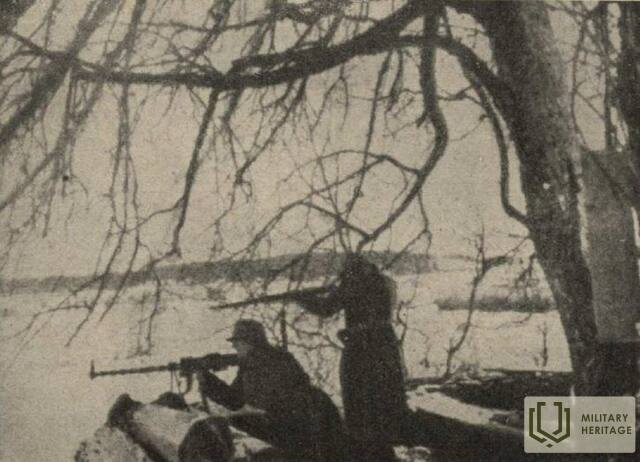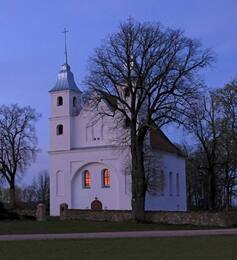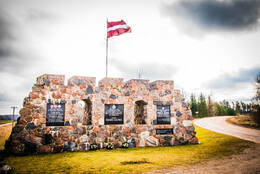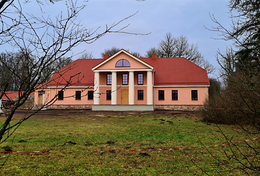Captain Aleksandar Leving's memories of a reconnaissance expedition over Venta near Lenas
In February 1919, both sides of the Venta River were active in reconnaissance activities. Captain Alexander Loeving, Chief of the Cavalry Division, was one of the commanders of the reconnaissance raids.
Another unforgettable reconnaissance march was on February 12. In the early morning, we rode out with 8 cavalrymen to Lēnai. Leaving our horses with the guard unit, we crossed the Venta River on foot to the other bank, where we began to move north under the cover of a cliff. We passed Pikuļi, where it was known that a red platoon was stationed. Then we approached Birznieki. There was noticeable movement near these houses and some carts were visible. I instructed Lt. (later Colonel) Pukšis to go there with some cavalrymen. I myself and the others returned to our bank of the Venta River, taking up positions at the edge of the forest near Kurmiei, so that we could support Itn. Pukšis' group with fire and cover its departure. The Bolsheviks soon noticed our scouts and wanted to turn them back. We opened fire, causing great confusion on the enemy's side. Now it was high time for our group to leave. I was afraid that if we went too fast, we would fall into the river, because in many places there was no ice cover. I went with Lieutenant Zariņš back across the river, marking the crossing point with needles. Then we crept through the coastal bushes to see where our group was. The covering fire from the Kurmi forest edge still continued. Suddenly, only about 100 meters away, we saw a group of reds running out of the nearby forest. We started shooting as much as we could from a standing position, in order to impress the enemy morally. The clash ended with the Bolsheviks hastily retreating from Birznieki. We all returned safe and sound, albeit in a sweat. With songs, we went to Lēnā, where we mounted horses to ride to Rudbārži with a message to the colonel.
Crippen A., Kalpak Battalion and the Dove Brigade, Belimora, 1963.
Related timeline
Related objects
Holy Trinity Roman Catholic Church in Lēni
The church is located in the village of Lēnu, Nīkrāce parish, Skrunda municipality, on the Skrunda - Embute road.
The Venta River is located near the church, the banks of which were guarded by soldiers of the 1st Separate Latvian Battalion in February 1919. As the battalion's numbers did not allow for a continuous front line, the front was guarded by sentry posts. One of them was also located on the bank of the river near the church. The church towers were useful for surveillance of the surrounding area and the other side of the river.
Memorial to the 1st Latvian Separate Battalion in Lėnai and relocation site on the Venta
The monument is located in Lēņi, at a road crossroads near Lēņi Manor.
The monument was unveiled on 8 November 2007. It was designed by sculptor Maija Engele. The author and financier of the monument is Jānis Blūms, whose father, Lieutenant Paulis Blūms, 1st Lieutenant of the 1st Separate Latvian Battalion Cavalry Division, organised and led the river crossing on 3 March 1919 with the help of 10 men.
Every year on 3 March, young guards, servicemen and other interested persons gather here for a commemorative event in honour of the 1st Latvian Separate Battalion.
Lēnu Manor
The manor castle is located in the village of Lēnu, by the Venta River. The castle is currently privately owned and can therefore only be seen from a distance.
The manor house was used as a support point by the 1st Latvian Separate Battalion from the end of January to 3 March 1919. The Latvian Separate Battalion had to liberate the surroundings of Leni Manor in order to be able to cross the river opposite Jaunmuiža.
The manor belonged to Baron Friedrich von Firks, who also owned the Rudbāržzi and Sieksate manors. The manor house was built in the 19th century. For the Baron, the castle of Lēnu served mainly as a place for hunting and weekend relaxation.
From 1927 to 1937 the castle was a school, and during the Soviet occupation it was a collective farm woodshop. In 1965, a community centre was opened. The ensemble of buildings has suffered many alterations and the park has not been preserved. Several outbuildings have survived.








